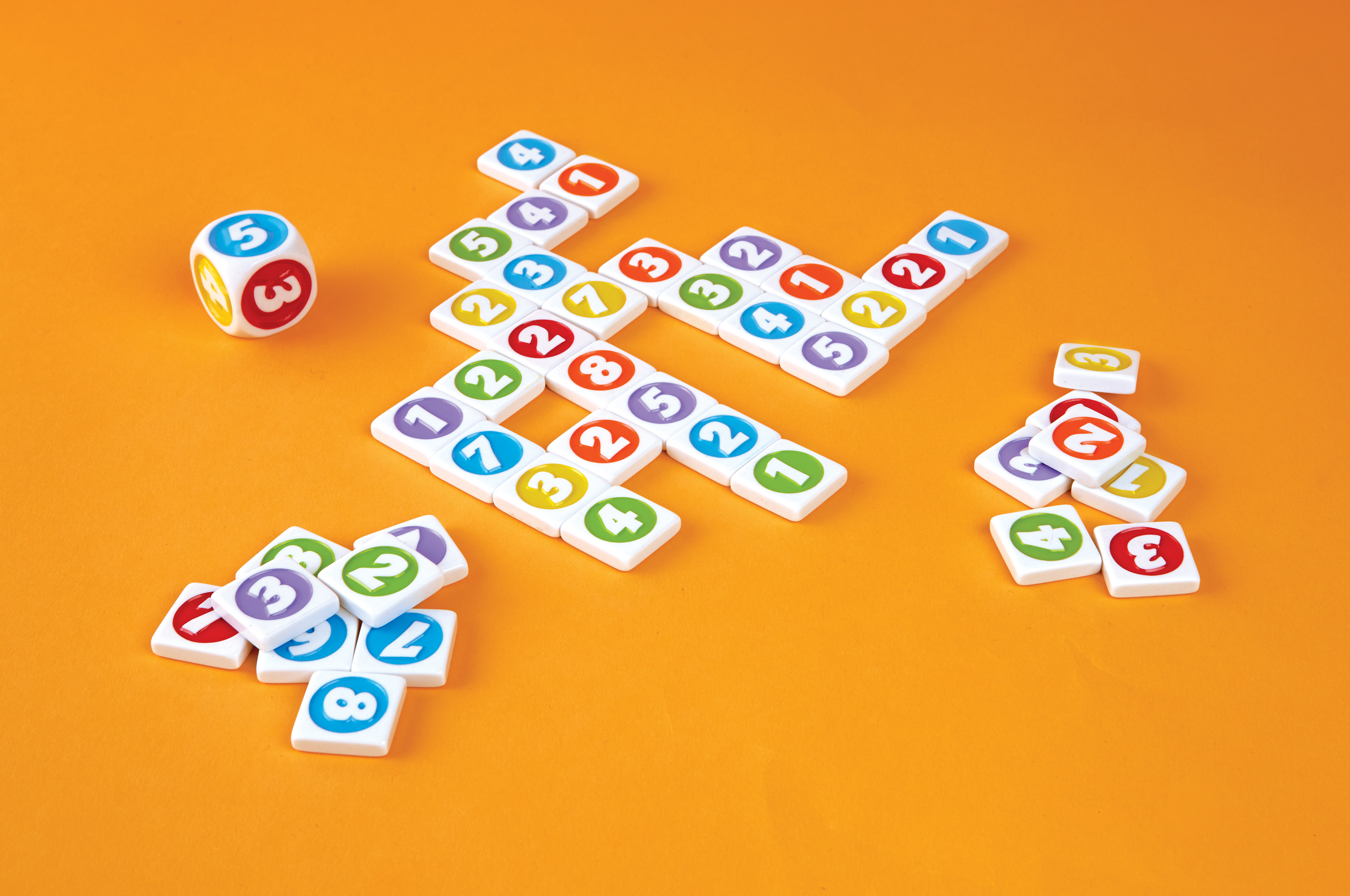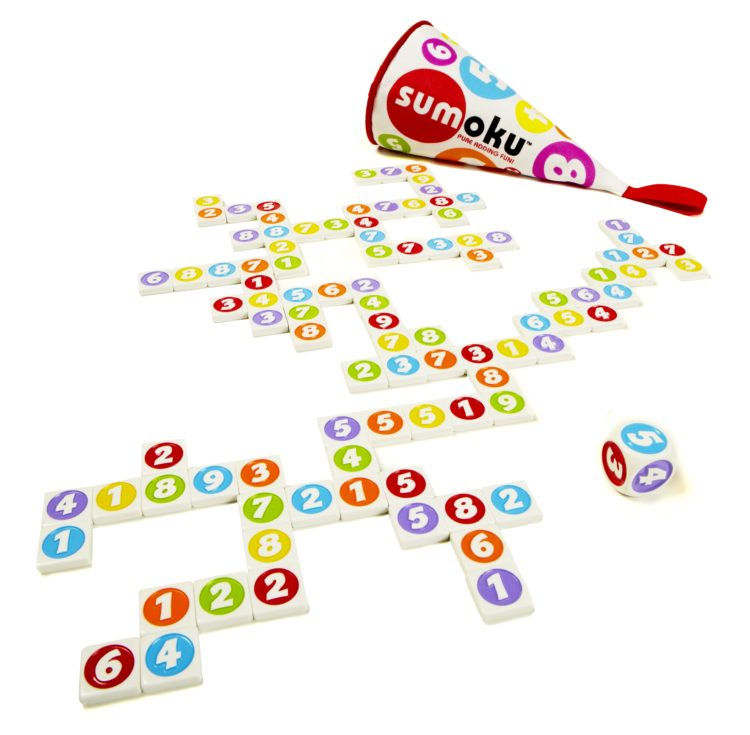 Sumoku is a crossword-style game that involves numbers and can be played with 1 to 8 players. The players roll the die to determine the Key Number (3, 4, or 5) which they use to create multiples in a grid format. Players create rows and columns of 2 to 6 numbers that add up to multiples of the Key Number. There are five different versions of this game: Sumoku, Speed Sumoku, Spot Sumoku, Team Sumoku and Solo Sumoku. Solo Sumoku can be played solitaire or in a group and is a great way to begin getting students comfortable finding multiples. Speed Sumoku and Spot Sumoku are more challenging games, which work better once students are more comfortable working with multiples.
Sumoku is a crossword-style game that involves numbers and can be played with 1 to 8 players. The players roll the die to determine the Key Number (3, 4, or 5) which they use to create multiples in a grid format. Players create rows and columns of 2 to 6 numbers that add up to multiples of the Key Number. There are five different versions of this game: Sumoku, Speed Sumoku, Spot Sumoku, Team Sumoku and Solo Sumoku. Solo Sumoku can be played solitaire or in a group and is a great way to begin getting students comfortable finding multiples. Speed Sumoku and Spot Sumoku are more challenging games, which work better once students are more comfortable working with multiples.
Game Instructions:
In all versions, tiles must be arranged in a crossword-style pattern of rows and columns. The rows and columns must add up to a multiple of the Key Number. The Key Number is determined by rolling the die. There are only 6 colors and they cannot be repeated in the same row or column. The “6” tile can be used as a “6” or a “9”. The die is only rolled once for the entire game.
 Sumoku (2-5 players):
Sumoku (2-5 players):
The object is to get the highest score. You gain points by adding the columns and rows you add to or create. All players contribute to one Sumoku pattern. All players draw 8 tiles and the one with the lowest total starts. The die is rolled to decide the Key Number. Players resupply their stock to 8 after each turn. If you add onto an existing row or column you add the new amount of that row plus any other rows or columns you create. You can play with a bonus rule that any time a player completes a line of 6 they play again without drawing new tiles. The game continues until all players have played as many tiles as possible. Then you add the numerical value of any tiles remaining and deduct that from your total.
Speed Sumoku (2-8 players):
The object is to race to be the first to assemble all your tiles in your own crossword-style pattern. To begin, place the tiles face down and shuffle. All players draw 10 tiles and place them face up in front of them. Roll the die and begin assembling your Sumoku. When the players are stuck they can swap 1 tile for 2 new tiles from the draw pile. When you complete your Sumoku grab the bag and shout “Sumoku”! Then the player on the right will check your Sumoku to ensure there are no mistakes. If a mistake is found you are out for this round and your tiles are returned to the draw pile. Each remaining player takes 2 more tiles and continues to play. At the beginning of the round, the previous winner rolls the die. The game ends when a player wins 2 rounds in a row or 3 rounds altogether.
 Spot Sumoku (2-8 players):
Spot Sumoku (2-8 players):
The object of the game is to be the first player to spot 4 tiles that add up to a multiple of the Key Number. The game begins with all the tiles face down in the middle. Take 10 tiles and turn them face up. Throw the die to determine the key number and search for 4 tiles. If you spot 4 tiles that add to a multiple of the key number shout out the total sum and assemble the tiles to show other players. If your combination is correct, keep the 4 tiles and draw 4 new tiles to begin a new round. If your combination is incorrect, return the 4 tiles to the draw pile and if you do not have 4 tiles, sit out the next round. In a game with 2-4 players, the first player to collect 16 tiles wins. In a game with 5-8 players, the first player to collect 12 tiles wins.
Team Sumoku (2, 3, or 4 teams of players):
The teams race to be the first to assemble all of their tiles to create a Sumoku. Each team receives the same number of tiles and places them face up (2 teams – 48 tiles, 3 teams – 32 tiles, 4 teams – 24 tiles). The first team to use all their tiles correctly wins the game.
 Solo Sumoku (1 player or 1 group):
Solo Sumoku (1 player or 1 group):
The object is to assemble the tiles in a Sumoku. First, you draw 16 tiles and roll the die to determine the key number. After you have assembled those 16 tiles you draw 10 additional tiles every time you finish. The goal is to use all 96 tiles. To add a challenge you can time yourself or the group to see how many tiles you can successfully add in a given time frame.
To access a PDF of the instructions please click here.
Curriculum Connections
Coming soon.
Connections to Processes
Communications [C]: During this game students will constantly check the work of their peers and ask for clarification when necessary. It is best to begin students in a non-competitive game (e.g. Solo Sumoku) to build their confidence working with multiples and explaining their strategies to other players. Students can be guided towards using mathematical language like “factors” and “multiples”. Also, older students can be guided towards discussing the “commutative” and “associative” properties connected to multiplication in the game.
Reasoning [R]: Students will challenge each other during the game to prove their answer is, in fact, a multiple of the key number. As students play the game multiple times, they will be able to generalize patterns and determine which strategies work the best. Then, they will be able to explain why certain strategies work for each of the five variations.
Problem Solving [PS]: Students will begin by facing the immediate problem of how to create a row or column that adds to a multiple of the key number. However, as they continue to play the game they will begin to create strategies that help them overall. They will discover that adding 1 or 2 tiles to complete existing rows or columns gains them more points. Also, that 3 is the easiest version and 5 is the most difficult because they have the highest and lowest number of multiples respectively, within a set amount. If the key number is 3 students will realize that they gain more points if they always use the “6” tile as a “9”. Another strategy they may discover is to try fitting the higher numbers together first and then supplementing with the lower numbers, this allows them to gain more points by playing the higher numbers. The multiple versions of this game allow students to practice the same skills in a game with slightly different goals and strategies.
Visualizing [V]: During this game, students should move from needing to physically place the pieces to determine if they work, towards being able to visualize potential moves. A challenge with visualizing in this game is that some pieces can be placed edge-to-edge with more than one piece and then students need to check that both rows/columns still add to a multiple of the key number. A twist in this game that students need to be aware of is the inclusion of color; you cannot have more than one tile of each colour in a row or column. For students who are not fluent at their multiples, they could place translucent chips on the multiples of the key number on a hundred chart and use it to help them work toward those values as they add.
Mental Mathematics and Estimation [ME]: Students will improve their computational fluency of multiples in this game. Students may begin by adding or subtracting to determine their solution but eventually, they will move towards mental calculation using multiplication and division. During the game students will select tiles and may discover that the sum is higher/lower than the target multiple, therefore they must trade a tile for a lower/higher-valued tile to achieve their goal. Students who are less comfortable multiplying/dividing may begin by multiplying/dividing with numbers they are more comfortable (e.g. 3×3) with and then adding/subtracting to reach their target multiple (e.g. [3×3]+3=3×4). Experiences such as these during the game will improve students’ mental math skills and eventually they will be able to fluently move between addition, subtraction, multiplication and division.
